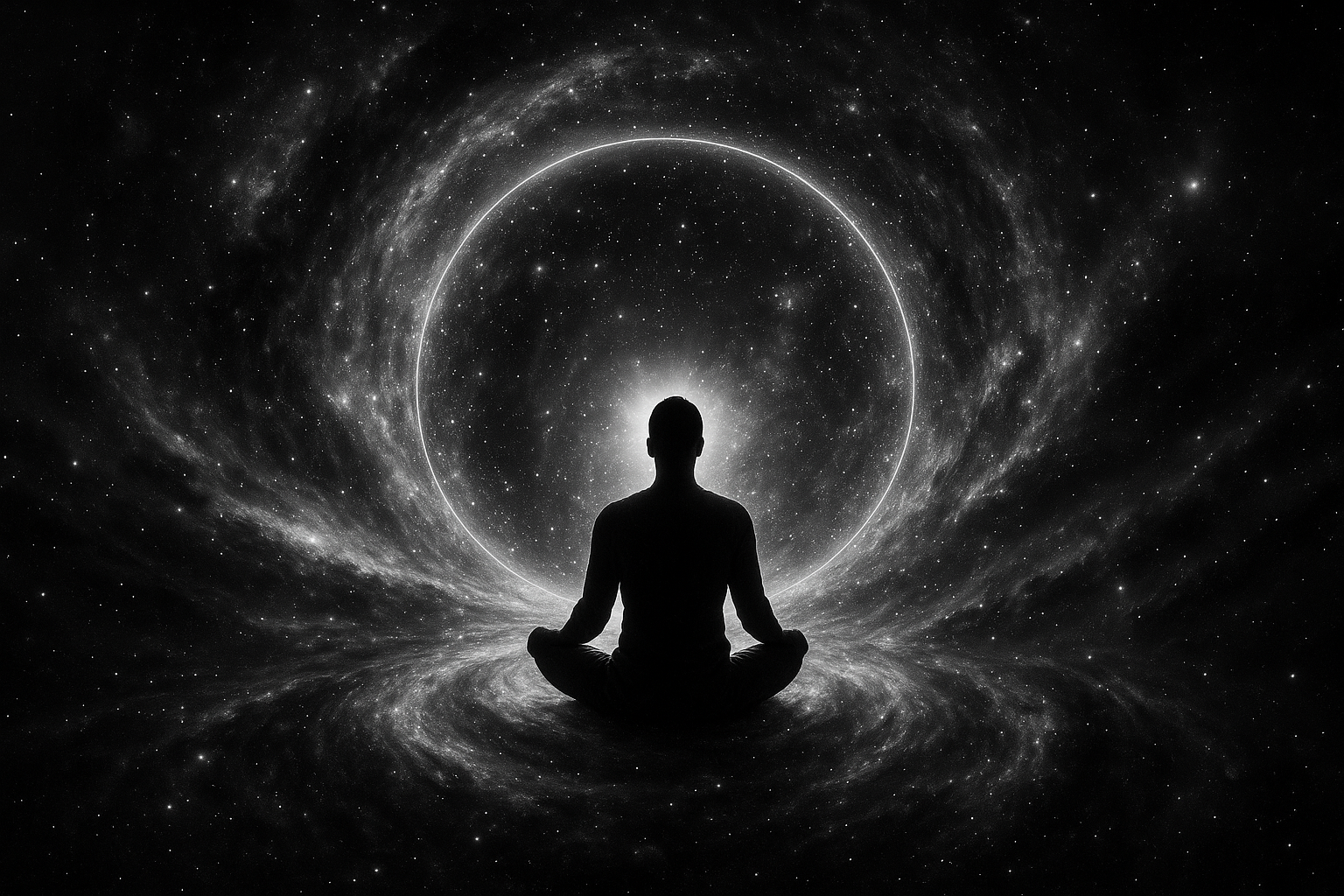The astral dimension is an energetic and spiritual plane that exists parallel to the physical world. It is also referred to as the astral plane, and is believed to be inhabited by subtle energies, entities, and beings that are beyond the comprehension of our everyday physical senses.
Astral projection is a practice where one’s consciousness separates from the physical body and allows individuals to enter this dimension and experience it directly. In yogic traditions, especially those followed by Himalayan yogis, the astral dimension is closely associated with the sukshma sharira or subtle body.
Through very advanced spiritual practices, individuals can learn how to engage with the astral plane and explore higher consciousness. This process, often referred to as astral travel, enables the practitioner to gain various levels of spiritual awareness and gain insights that transcend the limitations of the material world.
Table of Contents
Astral Projection – Historical and Cultural Perspectives
Astral projection has fascinated many, particularly those interested in spiritual growth, lucid dreaming, and metaphysical exploration. The astral projection is not just limited to out-of-body experiences (OBEs); it also includes the intentional movement of the astral body within different levels of the astral plane.
While the Yoga Sutras don’t explicitly mention “astral projection,” they do list siddhis (supernormal powers), such as leaving the body (parakaya-pravesha). Later interpretations often equate these abilities with astral travel, but this is a modern framing of older spiritual concepts.
In Amazonian cultures, astral projections are often facilitated through shamanic rituals involving powerful plant medicines like ayahuasca. This process of astral travel is seen as a vital aspect of personal and collective growth in these cultures.
The astral plane is also a prominent concept in Western esotericism, including theosophy and occultism, where astral projection is considered a means of reaching higher knowledge and enlightenment.
The writings of Helena Blavatsky and Alister Crowley discuss the astral plane as a realm of spiritual exploration, where consciousness can transcend the physical world and access hidden truths about the universe.
Astral Projection: Scientific Perspective
From a scientific standpoint, astral projection is often considered a psychological phenomenon, linked to altered states of consciousness such as lucid dreaming or near-death experiences (NDEs). Some neuroscientists believe that astral travel and astral projections can be explained by the brain’s interaction with different regions during deep states of meditation or REM sleep. The brain’s temporal lobe and parietal cortex are particularly active during such experiences, which could account for the vividness and realism associated with astral projection.
However, proponents of the astral plane argue that these experiences cannot be fully explained by science alone. The consistency of astral projections across cultures, and the profound transformations reported by those who practice it, suggest that there may be more to these experiences than simple brain activity.
What Does the Astral Dimension Look Like?
The astral plane is often described as a vast, ever-changing realm that exists outside the boundaries of our physical world. Unlike the rigid and structured nature of the physical universe, the astral plane is fluid and dynamic, with landscapes, colors, and energies that are shaped by the consciousness of the traveler. Through astral projection, individuals often describe vivid experiences where they journey through different aspects of this otherworldly realm.
The traditions teach that the astral travel experience can take on many forms, ranging from tranquil landscapes filled with light to dark, chaotic spaces filled with unresolved energies.
Similarly, in Amazonian shamanism, the appearance of the astral plane is often tied to the journeying process, which can vary dramatically depending on the individual’s state of consciousness and the ritualistic use of plant medicines like ayahuasca. Shamans report seeing vivid symbols, beings, and realms that are not only reflective of their own spiritual state but also shaped by the natural world and ancestral energies.
What People Experience During Astral Projection
When engaging in astral projection, individuals often report seeing a landscape that appears both surreal and familiar. Some describe floating through vast, endless spaces filled with brilliant colors, while others report seeing more structured environments like cities, mountains, or rivers. The key difference between the astral plane and physical reality is that the perception of space, time, and physical form becomes more fluid and subjective.
Common Descriptions of Astral Landscapes
- Bright, Luminous Spaces: Many practitioners report seeing spaces filled with radiant light, with colors more vibrant than anything experienced on Earth. These spaces may seem boundless, with no clear beginning or end. In yogic traditions, these luminous spaces are often associated with higher spiritual realms, where beings of light reside.
- Ethereal and Dreamlike Settings: Some astral projections involve dreamlike landscapes that may shift and change rapidly. This is particularly common in astral travel experiences where the traveler is not yet fully conscious of their surroundings. These dreamscapes may contain symbolic imagery tied to the individual’s inner psyche or unresolved emotional experiences.
- Physical-Like Environments: In some cases, individuals who project into the astral plane report seeing environments that are very similar to the physical world. These places might be familiar, such as houses or towns, but they are often slightly altered in some way.
Some researchers, particularly in the occult traditions, interpret these environments as being reflections of the astral traveler’s current state of consciousness or unresolved issues.
Astral Dreaming and the Subconscious Mind
Astral dreaming is a term used by many practitioners to describe dreams that occur during astral projection but are not bound by the same limitations as typical dreams. These experiences are often more vivid and involve deeper emotional processing. Some believe that astral projection travel into these dream states is a means of accessing higher levels of consciousness or exploring unresolved aspects of one’s life.
Common Symbols in the Astral Plane
In astral projection travel, individuals frequently encounter symbols, shapes, and figures that may not have a direct correlation to the physical world. These symbols are often viewed as representations of deeper spiritual truths, personal growth, or lessons that need to be learned. The appearance of these symbols can vary, but certain common themes emerge across cultures and spiritual systems.
- Beings of Light: Many travelers describe encountering ethereal beings that are made of pure light or energy. In yogic traditions, these beings are often interpreted as deities, guides, or advanced spiritual beings who assist the traveler in navigation.
- Geometric Patterns: Geometric shapes such as spirals, grids, or circles are frequently reported by those who practice astral projection. These shapes are seen as representations of the structure of the universe or higher states of consciousness.
- Portals and Gateways: A common feature in astral projection is the encounter with portals or gateways that lead to different parts of the astral plane. These portals can appear as doorways, windows, or tunnels and often symbolize transitions or shifts in consciousness.
What Shapes the Appearance of the Astral Dimension?
The astral plane is often viewed as a manifestation of the collective and individual consciousness. This suggests that the astral plane is not a singular, fixed reality, but rather one that adapts and reflects the consciousness of those who enter it. Several factors influence what one might encounter in the astral plane:
- Personal Vibration and Emotional State: If someone is carrying negative emotions or unresolved trauma, they may encounter darker, denser realms in the lower astral plane. Conversely, a calm, balanced individual may find themselves in lighter, more peaceful regions of the astral dimension.
- Intention and Focus: The traveler’s purpose and clarity of intent also play a role in shaping their astral projection experience. Those seeking spiritual growth, guidance, or healing may have a vastly different experience than those with no clear intent or those focused on personal exploration.
- Spiritual Growth: As one progresses spiritually, the quality of their astral travel improves, allowing them to venture into higher realms of consciousness and gain deeper insights. Astral projection meaning changes as one matures spiritually, with experiences becoming more profound and insightful.
Sources and References
Out-of-Body Experiences and Brain Activity – Study on OBEs and their scientific explanations. Available at: https://pubmed.ncbi.nlm.nih.gov
The Yoga Sutras of Patanjali – Translated by Swami Sivananda. https://yogasutrasofpatanjali.org
Shamanic Journeys and the Astral Plane – An exploration of Amazonian practices and their connection to the astral projection. https://www.ayahuasca.com
Out-of-Body Experiences and Neuroscience – Study on OBEs, available at: https://pubmed.ncbi.nlm.nih.gov
Sadhguru’s Teachings on Astral Projection and Consciousness – Isha Foundation, available at: https://isha.sadhguru.org
The Yoga Sutras of Patanjali – Translated by Swami Sivananda, available at: https://yogasutrasofpatanjali.org
Ayahuasca and Amazonian Shamanism – Ethnobotanical studies by Dr. Dennis McKenna, available at: https://www.ayahuasca.com


Leave a Reply